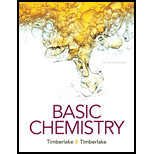
(a)
Interpretation:
To analyze the substance getting reduced in the given
Concept Introduction:
A
A chemical equation is a symbolic representation of the given chemical reaction in the form of symbols and chemical formulas of the reactants and products. When we write a balanced chemical equation we mean that the number of atoms and charges for each of the elements present in the reaction must be same.
(b)
Interpretation:
To analyze the substance getting oxidized in the given chemical reaction.
Concept Introduction:
A redox reaction is meant to take place when the oxidation states of the atoms present in a chemical species are changed. In such type of reaction, both oxidation and reduction of two different atoms present in the reactant molecules take place simultaneously. Any reactant is said to be oxidized when an atom present in a reactant molecule transfers electrons to other chemical species. In such type of reactions, the oxidation state of the atom, molecule or ions changes. When oxidation reaction takes place, then loss of electrons occurs from that species which is undergoing oxidation, which results in increase in oxidation number. However, when reduction reaction takes place, there occurs gain of electrons by the species undergoing reduction. Since, in redox reaction, both oxidation and reduction takes place simultaneously on two or more different atoms or ions. In these types of reactions, the species which looses electrons is said to be oxidized and is known as reducing agent while the species which gains electrons is said to be reduced and is said to be an oxidizing agent. Reduction of a chemical species results in decrease in its oxidation number.
A chemical equation is a symbolic representation of the given chemical reaction in the form of symbols and chemical formulas of the reactants and products. When we write a balanced chemical equation we mean that the number of atoms and charges for each of the elements present in the reaction must be same.
(c)
Interpretation:
The oxidizing agent in the given chemical reaction is to be stated.
Concept Introduction:
A redox reaction is meant to take place when the oxidation states of the atoms present in a chemical species are changed. In such type of reaction, both oxidation and reduction of two different atoms present in the reactant molecules take place simultaneously. Any reactant is said to be oxidized when an atom present in a reactant molecule transfers electrons to other chemical species. In such type of reactions, the oxidation state of the atom, molecule or ions changes. When oxidation reaction takes place, then loss of electrons occurs from that species which is undergoing oxidation, which results in increase in oxidation number. However, when reduction reaction takes place, there occurs gain of electrons by the species undergoing reduction. Since, in redox reaction, both oxidation and reduction takes place simultaneously on two or more different atoms or ions. In these types of reactions, the species which looses electrons is said to be oxidized and is known as reducing agent while the species which gains electrons is said to be reduced and is said to be an oxidizing agent. Reduction of a chemical species results in decrease in its oxidation number.
A chemical equation is a symbolic representation of the given chemical reaction in the form of symbols and chemical formulas of the reactants and products. When we write a balanced chemical equation we mean that the number of atoms and charges for each of the elements present in the reaction must be same.
(d)
Interpretation:
The reducing agent in the given chemical reaction is to be stated.
Concept Introduction:
A redox reaction is meant to take place when the oxidation states of the atoms present in a chemical species are changed. In such type of reaction, both oxidation and reduction of two different atoms present in the reactant molecules take place simultaneously. Any reactant is said to be oxidized when an atom present in a reactant molecule transfers electrons to other chemical species. In such type of reactions, the oxidation state of the atom, molecule or ions changes. When oxidation reaction takes place, then loss of electrons occurs from that species which is undergoing oxidation, which results in increase in oxidation number. However, when reduction reaction takes place, there occurs gain of electrons by the species undergoing reduction. Since, in redox reaction, both oxidation and reduction takes place simultaneously on two or more different atoms or ions. In these types of reactions, the species which looses electrons is said to be oxidized and is known as reducing agent while the species which gains electrons is said to be reduced and is said to be an oxidizing agent. Reduction of a chemical species results in decrease in its oxidation number.
A chemical equation is a symbolic representation of the given chemical reaction in the form of symbols and chemical formulas of the reactants and products. When we write a balanced chemical equation we mean that the number of atoms and charges for each of the elements present in the reaction must be same.
Want to see the full answer?
Check out a sample textbook solution
Chapter 15 Solutions
Basic Chemistry (5th Edition)
 ChemistryChemistryISBN:9781305957404Author:Steven S. Zumdahl, Susan A. Zumdahl, Donald J. DeCostePublisher:Cengage Learning
ChemistryChemistryISBN:9781305957404Author:Steven S. Zumdahl, Susan A. Zumdahl, Donald J. DeCostePublisher:Cengage Learning ChemistryChemistryISBN:9781259911156Author:Raymond Chang Dr., Jason Overby ProfessorPublisher:McGraw-Hill Education
ChemistryChemistryISBN:9781259911156Author:Raymond Chang Dr., Jason Overby ProfessorPublisher:McGraw-Hill Education Principles of Instrumental AnalysisChemistryISBN:9781305577213Author:Douglas A. Skoog, F. James Holler, Stanley R. CrouchPublisher:Cengage Learning
Principles of Instrumental AnalysisChemistryISBN:9781305577213Author:Douglas A. Skoog, F. James Holler, Stanley R. CrouchPublisher:Cengage Learning Organic ChemistryChemistryISBN:9780078021558Author:Janice Gorzynski Smith Dr.Publisher:McGraw-Hill Education
Organic ChemistryChemistryISBN:9780078021558Author:Janice Gorzynski Smith Dr.Publisher:McGraw-Hill Education Chemistry: Principles and ReactionsChemistryISBN:9781305079373Author:William L. Masterton, Cecile N. HurleyPublisher:Cengage Learning
Chemistry: Principles and ReactionsChemistryISBN:9781305079373Author:William L. Masterton, Cecile N. HurleyPublisher:Cengage Learning Elementary Principles of Chemical Processes, Bind...ChemistryISBN:9781118431221Author:Richard M. Felder, Ronald W. Rousseau, Lisa G. BullardPublisher:WILEY
Elementary Principles of Chemical Processes, Bind...ChemistryISBN:9781118431221Author:Richard M. Felder, Ronald W. Rousseau, Lisa G. BullardPublisher:WILEY





